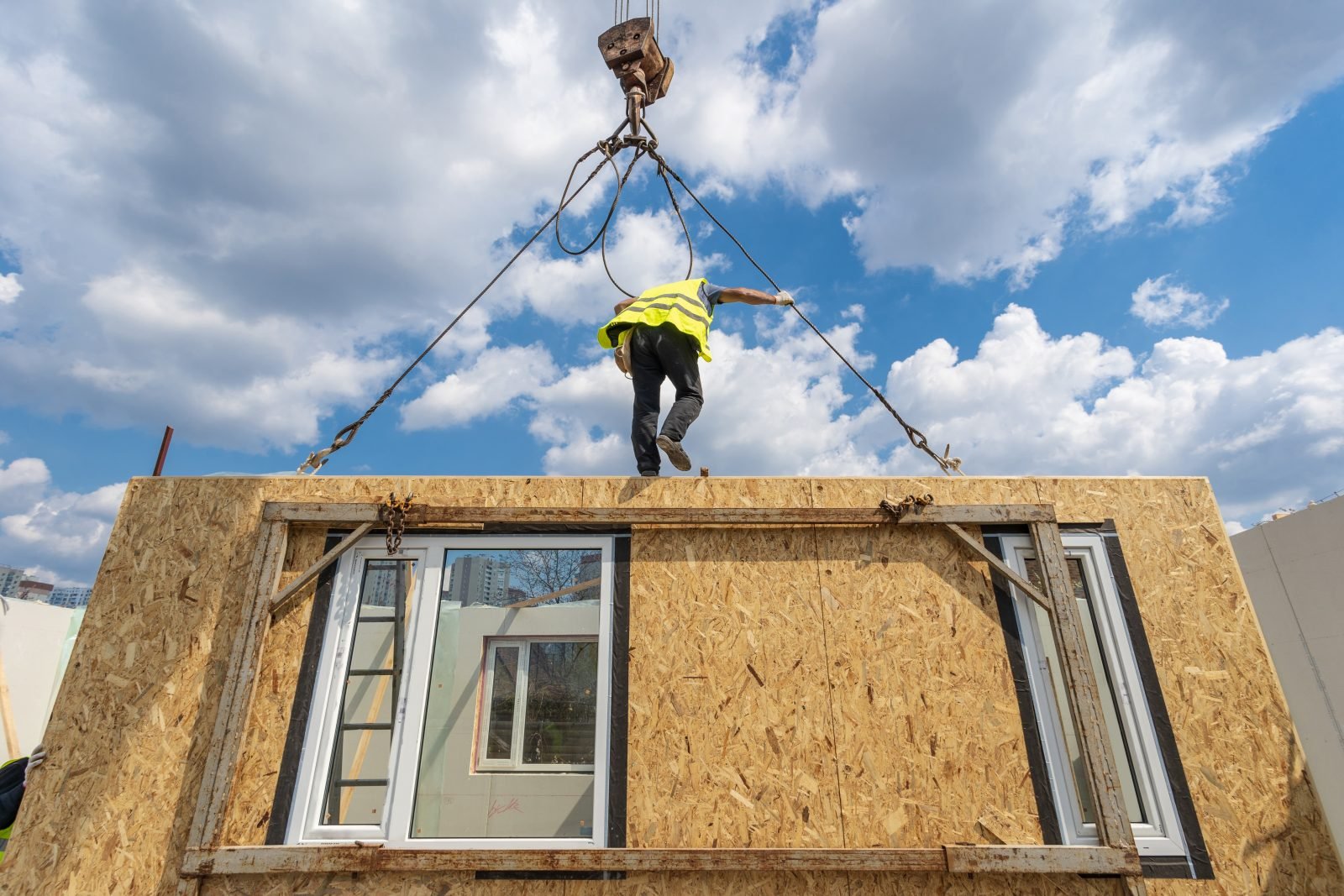Is modular construction the future of housing?
Exploring the benefits and drawbacks of building modular homes at scale.
The housing industry is smack in the middle of a step change. The industry as a whole has to start making headway to a more carbon-efficient future while addressing the ever-present need for new homes. Not just in the UK but across much of the developed world, there is a shortage of affordable new homes with demand outstripping supply.
Any solution to this needs to be two-pronged. On one hand, we need a strategy that’s going to allow us to remove carbon from the supply chain and the building process. On the other, any strategy needs to be viable at scale and cost-efficient to address the stark housing shortfall.
In this short blog, we’re putting modular construction under the microscope to understand how it can help us address the issues facing the industry and the areas where there’s still a need for innovation.
What is modular construction?
Put simply, modular construction is about producing prefabricated components or modules in a factory setting, bringing them to site as composite pieces and installing them in their respective positions.
The kind of components that arrive at site prefabricated can be anything from facades and flooring, right the way through to complete units like rooms and even full structures.
Modular construction is not a new concept, existing since the 19th century it’s been a part of our building practices for over 100 years. In relatively recent times, the process has seen an explosion of interest due to its viability in helping us to address the big problems facing the industry.
Modular construction is more carbon efficient than traditional methods
The construction of buildings is estimated to contribute a whopping 39% to global carbon emissions. The running and energy needed to heat these buildings contribute 28% to that figure and the remaining 11% is produced by materials and the building process.
With the push towards a net-zero society and the various targets that have been put forward by the UK government for our industry, a big responsibility falls on anyone working within the built environment to start addressing their carbon output.
The modular approach to building cuts emissions in several areas, with studies finding that the method cuts carbon emissions by up to 42% when compared to traditional methods.
Less vehicular transport is required to take materials to site
Less on-site workers are required for installation when compared to traditional approaches.
Less carbon-intensive materials like concrete and steel are required for modular builds
Because factory production is less error-prone than onsite construction, costly mistakes and problems occur less frequently, requiring less carbon-intensive workarounds
Modular builds tend to be more airtight, improving energy efficiency once built
Because modular builds are quicker, less time is spent on site overall
While modular construction brings with it a slew of carbon-saving benefits, it’s not the sole answer to decarbonising our industry. It will prove to be a vital tool going forward, but more innovation is needed in terms of raw materials and energy solutions if we’re to hit our targets.
Mohsin Cooper on a tour of Boutique Modern Ltd
The UK housing need
The government has set the country an ambitious target to create 300,000 new homes each year. So far, that figure has gone unrealised with last year’s effort falling far short at 216,000. Even within that number of new houses, there’s still a large affordability issue, with rampant house prices pricing many families out of the market.
On top of the issue of raw numbers, many houses are of such poor quality that it’s estimated some housing could be costing the NHS £1.4 billion a year in treatment bills.
We’ve already seen that modular construction methods can prove a vital tool in addressing the industry’s carbon problem, but what about its viability when applied to the large-scale production of new homes?
The argument for Modular construction as a solution to the housing crisis
With the 300,000 new homes target set by the government, increased speed and reduced costs are extremely important factors in any successful strategy. The question is, can modular construction deliver that?
Speed
To begin with, modular construction is around 10-50% faster than traditional construction methods. Much of the speed benefit is down to the fact that a significant amount of the work is done on a factory floor. The reasons factory production is often quicker include the following considerations:
Factory environments are designed to maximise efficiency that wouldn’t be possible on a work site
Because the factory environment is essentially hidden from public view, there’s less disruption to communities and neighbours when the lion’s share of the work is completed off-site. This cuts down on time-consuming workarounds that avoids disturbing nearby residents
Work on-site and work in the factory is often performed alongside each other, meaning two streams of building and production are happening simultaneously
Weather conditions are often limiting factors on a building site. When production is completed within the shelter of a factory floor, weather conditions cease to be an issue
Costs
Depending on the development, modular construction methods can often reduce costs by 10-35%. By its nature, modular construction standardises processes and certain elements of design. In essence, the design and production of modular components become repeatable processes, reducing design time and reducing costs through economy of scale.
The highly controlled conditions that the factory environment provides also means there’s much less waste of raw materials and the quicker build times bring the added benefit of lower labour costs.
Mohsin Cooper on a tour of Boutique Modern Ltd
The challenges facing modular construction
The main compromise you make when pursuing modular construction over traditional methods is that you become more restricted with design and lack the same freedom to customise that you get with traditional methods.
A good counter to this is that the housing crisis is not borne out of a lack of bespoke homes, it’s a crisis borne out of a lack of good quality affordable homes. We’ve already seen that modular construction can help us develop homes faster, cheaper and with increased environmental efficiency. That these homes lack the same customisation options as traditionally built homes should not necessarily be seen as a negative.
Site constraints and access requirements
One small complicating factor when it comes to modular builds is that sites need to be appropriately structured to allow for large modular components to be delivered and installed. For instance, if you have an access point that is merely a narrow mud road, you’re going to struggle to get the transport vehicles and larger modular components to the desired space.
Similarly, if a site is an odd shape, the fitting of modular components could prove an issue, especially when the site requires custom elements or non-rectangular installations.
In the majority of cases, access and site challenges are solvable problems so shouldn’t be seen as a nail in the modular coffin, but there may indeed be some sites where modular installations become significantly complicated.
Public opinions of quality
Rightly or wrongly, some of the general public doubt that modular construction offers the same quality as traditional builds. When you mention modular, some may think immediately of the pre-fabricated homes of the 1950s rather than the modern equivalent. A challenge for developers and the country at large is to educate the buying public about the benefits of modular, the increased quality and the cost savings it offers both in terms of initial purchase and energy supply.
Does modular offer the right solutions to the housing crisis?
As we’ve just seen, modular construction is a powerful tool to have in our arsenal when addressing the need for more affordable housing in the UK. But it’s not a silver bullet that will alleviate all of our problems.
It will offer a cheaper and quicker alternative to traditional methods, but as some have argued, it doesn’t address one of the biggest bottlenecks keeping us from reaching the 300,000 target.
As argued elsewhere, capacity has never truly been the limiting factor in meeting the government’s ambition for new homes. The planning system in the UK simply doesn’t allow for that volume of homes to be built.
No matter what method you’re using to build your homes, you can’t build them until planning comes in.
The question of how to reform our planning system to help us solve the housing crisis is a big question and one we’ll devote the required time to in another blog. For now, we’ll just say that reform to the planning process would be a vital step forward in the push to deliver much-needed affordable homes across the country.
-
Modular construction is an extremely potent tool that will play a large part in the future of our built environment. As we future-proof our industry and evolve with the times, new methods, materials and approaches will join the fray and put us on the path towards environmental sustainability, healthier communities and a plentiful housing supply.
If you’re looking for help with planning or creating the perfect architectural design, Mohsin Cooper can help you bring your site to life. For a no-obligation consultation, contact us today.



